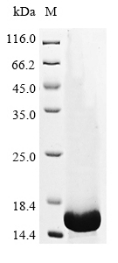The synthesis of recombinant mouse Tgfb1 protein begins with cloning the Tgfb1 gene fragment (279-390aa) with the N-terminal 6xHis-tag gene into an appropriate expression vector. This vector is then introduced into E.coli cells to promote protein expression. After expression, the protein undergoes a series of purification steps, typically using affinity chromatography. Post-purification, SDS-PAGE is used to evaluate the purity of the protein, exceeding 85%.
Tgfb1 is a pivotal cytokine involved in various biological processes, including cell growth, differentiation, and apoptosis. In mice, Tgfb1 plays a crucial role in several physiological and pathological contexts, particularly regulating immune responses, tissue repair, and fibrosis. Its multifaceted functions are mediated through complex signaling pathways that influence cellular behavior in various tissues, including the liver, lungs, and cartilage.
Tgfb1 is recognized for its significant role in fibrogenesis, particularly in liver diseases such as non-alcoholic steatohepatitis (NASH) and liver cirrhosis. It activates hepatic stellate cells, which are responsible for extracellular matrix deposition, thereby contributing to fibrosis progression [1][2][3]. In models of liver injury, Tgfb1 signaling is often over-activated, leading to increased hepatocyte apoptosis and inflammation [4][5]. This cytokine's involvement in liver pathology underscores its importance as a therapeutic target for conditions characterized by excessive fibrosis and inflammation [2][5].
In the context of lung diseases, Tgfb1 is implicated in the development of pulmonary fibrosis by promoting the activation and differentiation of fibroblasts into myofibroblasts, which are key effector cells in fibrotic processes [6][7]. The signaling pathways activated by Tgfb1 can lead to the production of extracellular matrix components, further exacerbating lung tissue remodeling and dysfunction [6][7]. This role in fibrosis is not limited to the liver and lungs. Tgfb1 also influences cartilage metabolism, where it can modulate chondrocyte behavior, impacting conditions such as osteoarthritis [8][9][10].
References:
[1] L. Dc, K. Wang, et al. Ets-1 deficiency alleviates nonalcoholic steatohepatitis via weakening tgf-β1 signaling-mediated hepatocyte apoptosis, Cell Death and Disease, vol. 10, no. 6, 2019. https://doi.org/10.1038/s41419-019-1672-4
[2] I. Fabregat, J. Moreno-Càceres, et al. tgf‐β signalling and liver disease, Febs Journal, vol. 283, no. 12, p. 2219-2232, 2016. https://doi.org/10.1111/febs.13665
[3] K. Doh, H. Jung, I. Moon, H. Kang, J. Park, & J. Park. Prevention of ccl4-induced liver cirrhosis by ribbon antisense to transforming growth factor-β1, International Journal of Molecular Medicine, 2008. https://doi.org/10.3892/ijmm.21.1.33
[4] L. Yang, Y. Roh, et al. Transforming growth factor beta signaling in hepatocytes participates in steatohepatitis through regulation of cell death and lipid metabolism in mice, Hepatology, vol. 59, no. 2, p. 483-495, 2013. https://doi.org/10.1002/hep.26698
[5] Z. Wang, Y. Tong, & Z. Song. Extracellular signal-regulated kinases 1/2 suppression aggravates transforming growth factor-beta1 hepatotoxicity: a potential mechanism for liver injury in methionine-choline deficient-diet-fed mice, Experimental Biology and Medicine, vol. 235, no. 11, p. 1347-1355, 2010. https://doi.org/10.1258/ebm.2010.010160
[6] Y. Kong, F. Sun, X. Wang, & L. Shi. Naringin attenuates the fibrosis of transforming growth factor-beta 1 induced human embryonic lung fibroblasts through nuclear factor kappa b pathway, IJPS, vol. 85, no. 2, 2022. https://doi.org/10.36468/pharmaceutical-sciences.1107
[7] H. Gong, C. Zheng, X. Lyu, L. Dong, S. Tan, & X. Zhang. Inhibition of sirt2 alleviates fibroblasts activation and pulmonary fibrosis via smad2/3 pathway, Frontiers in Pharmacology, vol. 12, 2021. https://doi.org/10.3389/fphar.2021.756131
[8] E. Davidson, A. Scharstuhl, E. Vitters, P. Kraan, & W. Berg. Untitled, Arthritis Research & Therapy, vol. 7, no. 6, p. R1338, 2005. https://doi.org/10.1186/ar1833
[9] J. Iqbal, J. Dudhia, J. Bird, & M. Bayliss. Age-related effects of tgf-β on proteoglycan synthesis in equine articular cartilage, Biochemical and Biophysical Research Communications, vol. 274, no. 2, p. 467-471, 2000. https://doi.org/10.1006/bbrc.2000.3167
[10] M. Gómez-Camarillo and J. Kourí. Ontogeny of rat chondrocyte proliferation: studies in embryo, adult and osteoarthritic (oa) cartilage, Cell Research, vol. 15, no. 2, p. 99-104, 2005. https://doi.org/10.1038/sj.cr.7290273






